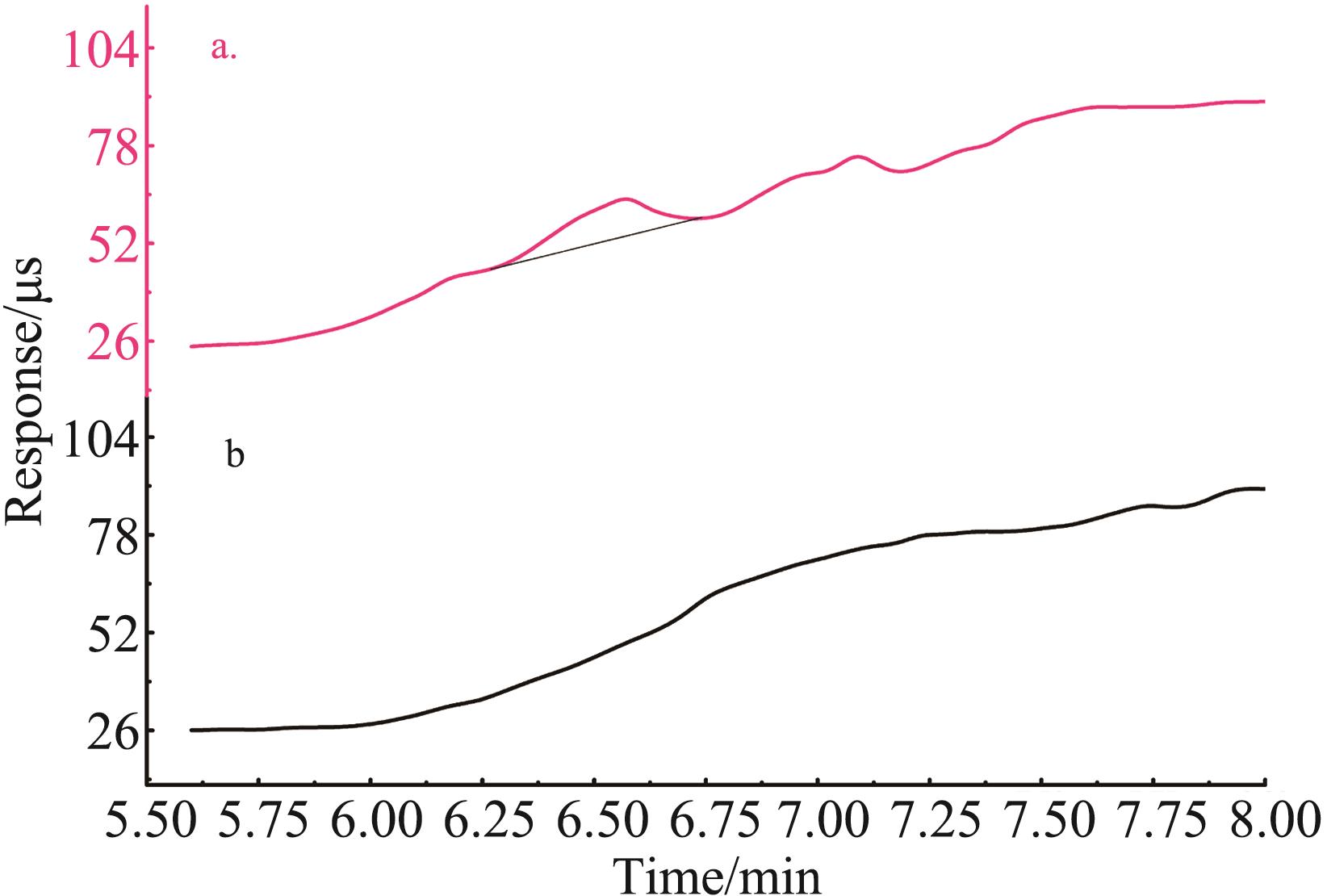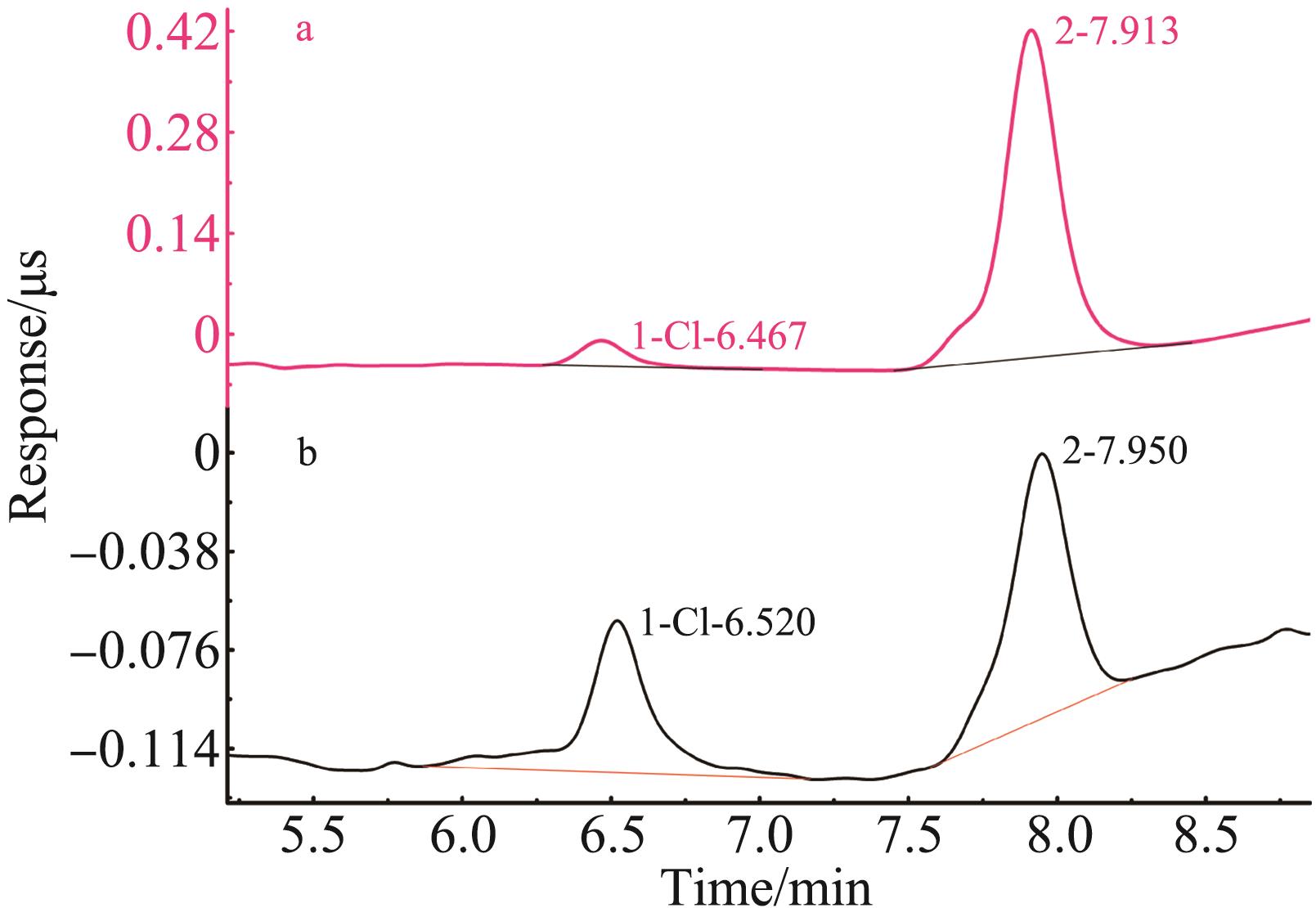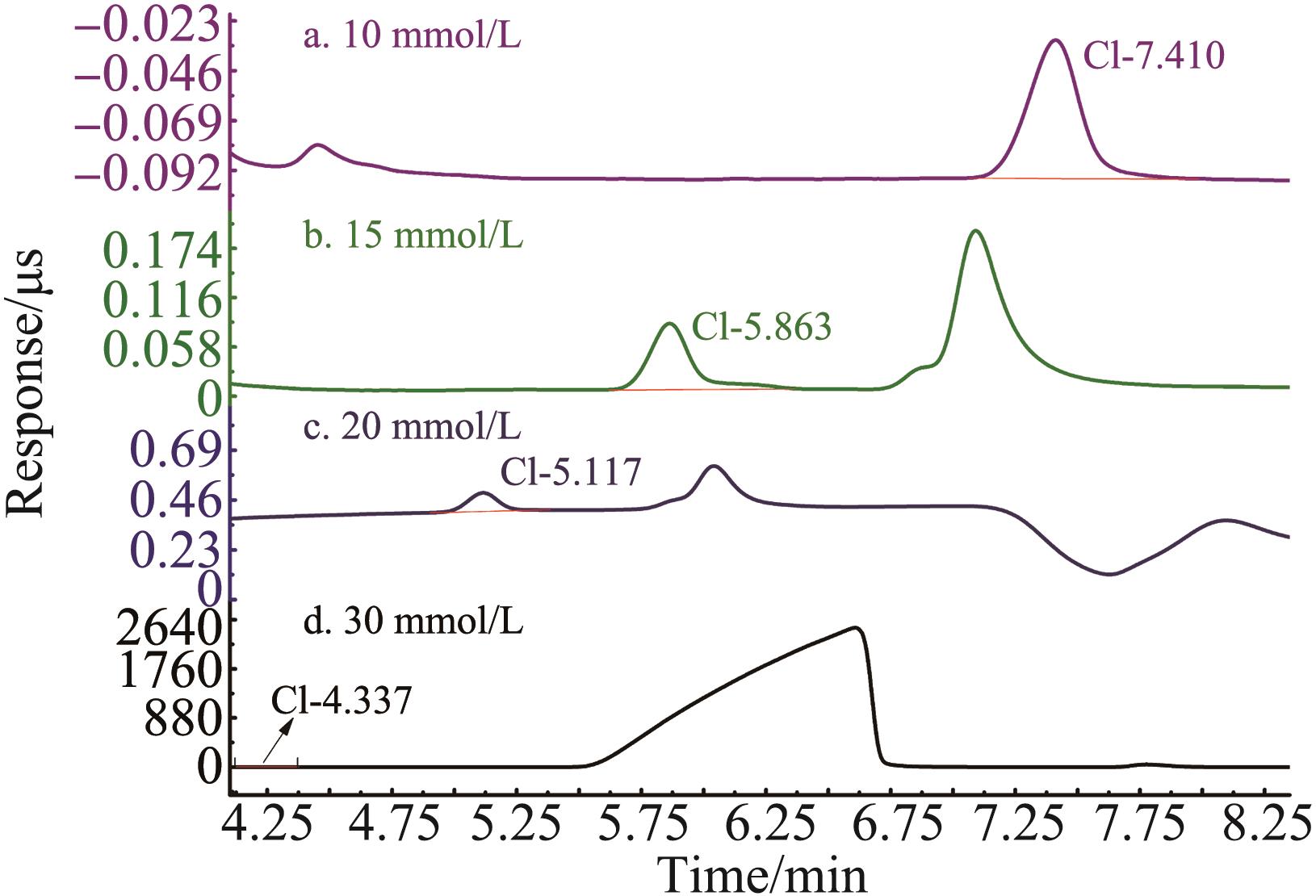
Chinese Journal of Applied Chemistry ›› 2022, Vol. 39 ›› Issue (9): 1412-1420.DOI: 10.19894/j.issn.1000-0518.210444
• Full Papers • Previous Articles Next Articles
Ion Chromatographic Method for the Determination of Chlorine Content in Titanium Sponge
Mi-Fang DU1( ), Guo-Liang CHANG1, Pan LIU1, Yi ZHANG1, Xin-Yao ZHANG1,2,3, Jing-Bin LI1
), Guo-Liang CHANG1, Pan LIU1, Yi ZHANG1, Xin-Yao ZHANG1,2,3, Jing-Bin LI1
- 1.Luo Yang Ship Materials Institute,Luoyang 471023,China
2.Henan Key Laboratory of Technology and Application of Structural Materials for Ships and Marine Equipments,Luoyang 471023,China
3.National New Material Production and Application Demonstration Platform (Advanced Marine Engineering and High-tech Ship Materials),Luoyang 471023,China
-
Received:2021-09-01Accepted:2022-01-05Published:2022-09-01Online:2022-09-08 -
Contact:Mi-Fang DU -
About author:du_mifang@725.com.cn
-
Supported by:the National New Material Production and Application Demonstration Platform (Advanced Marine Engineering and High?tech Ship Materials) Fund Project(TC180A6MR/2)
CLC Number:
Cite this article
Mi-Fang DU, Guo-Liang CHANG, Pan LIU, Yi ZHANG, Xin-Yao ZHANG, Jing-Bin LI. Ion Chromatographic Method for the Determination of Chlorine Content in Titanium Sponge[J]. Chinese Journal of Applied Chemistry, 2022, 39(9): 1412-1420.
share this article
Add to citation manager EndNote|Ris|BibTeX
URL: http://yyhx.ciac.jl.cn/EN/10.19894/j.issn.1000-0518.210444
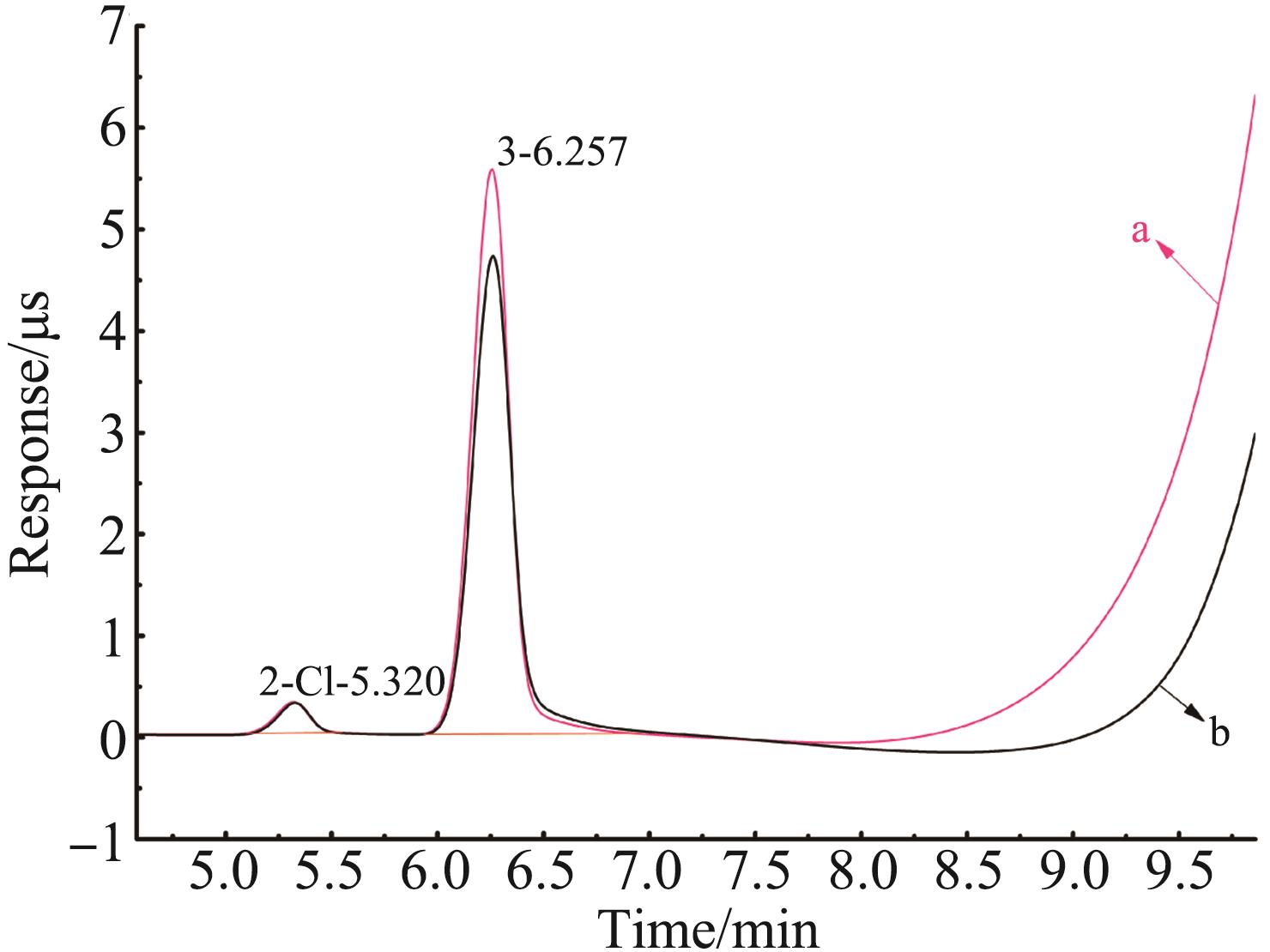
Fig.3 Chromatogram of the sample after dissolving with sulfuric acid, adding nitric acid and heating for 1 min (a) and 3 min (b) when the concentration of eluent is 15 mmol/L

Fig.4 Chromatograms of the diluted titanium sponge sample after dissolving with sulfuric acid,adding nitric acid without heating and standing for a moment(b and c)and heating nitrogen(a and d) (The concentration of eluent:5 mmol/L)
试样编号 Sample No. | 海绵钛质量 m(titanium sponge)/g | 定容体积 Constantvolume/mL | 稀释倍数 Dilution factor | 钛含量 Titanium ion content/(μg·mL-1) | 使用的过滤柱个数 Number of filter columns used | |
|---|---|---|---|---|---|---|
H柱过滤前(半定量分析) Before filtering by H?filter column (Semi?quantitative analysis) | H柱过滤后 After filtering by H?filter column | |||||
| 1# | 0.103 23 | 100 | 10 | 97.79 | 0.0045 | 2 |
| 2# | 0.101 36 | 100 | 10 | 99.74 | 0.048 | 1 |
| 3# | 0.099 57 | 100 | 10 | 99.94 | 0.074 | 1 |
| 4# | 0.101 55 | 100 | 10 | 99.89 | 0.042 | 1 |
| 5# | 0.102 70 | 100 | 10 | 97.91 | 0.021 | 1 |
| 6# | 0.102 72 | 100 | 10 | 97.57 | 0.016 | 1 |
| 7# | 0.104 10 | 100 | 10 | 98.27 | 0.048 | 1 |
| 8# | 0.104 21 | 100 | 10 | 98.73 | 0.033 | 1 |
| 9# | 0.104 36 | 100 | 10 | 97.79 | 0.052 | 1 |
| 10# | 0.101 52 | 100 | 10 | 98.90 | 0.048 | 1 |
| 11# | 0.104 00 | 100 | 10 | 未测 (约100) Unmeasured (about 100) | 0.053 | 1 |
| 12# | 0.102 34 | 100 | 10 | 未测 (约100) Unmeasured (about 100) | 0.064 | 1 |
| 13# | 0.099 99 | 100 | 10 | 未测 (约100) Unmeasured (about 100) | 0.059 | 1 |
| 14# | 0.100 35 | 100 | 10 | 未测 (约100) Unmeasured (about 100) | 0.015 | 1 |
Table 1 Titanium ion content in solution before and after filtration by H?filter column
试样编号 Sample No. | 海绵钛质量 m(titanium sponge)/g | 定容体积 Constantvolume/mL | 稀释倍数 Dilution factor | 钛含量 Titanium ion content/(μg·mL-1) | 使用的过滤柱个数 Number of filter columns used | |
|---|---|---|---|---|---|---|
H柱过滤前(半定量分析) Before filtering by H?filter column (Semi?quantitative analysis) | H柱过滤后 After filtering by H?filter column | |||||
| 1# | 0.103 23 | 100 | 10 | 97.79 | 0.0045 | 2 |
| 2# | 0.101 36 | 100 | 10 | 99.74 | 0.048 | 1 |
| 3# | 0.099 57 | 100 | 10 | 99.94 | 0.074 | 1 |
| 4# | 0.101 55 | 100 | 10 | 99.89 | 0.042 | 1 |
| 5# | 0.102 70 | 100 | 10 | 97.91 | 0.021 | 1 |
| 6# | 0.102 72 | 100 | 10 | 97.57 | 0.016 | 1 |
| 7# | 0.104 10 | 100 | 10 | 98.27 | 0.048 | 1 |
| 8# | 0.104 21 | 100 | 10 | 98.73 | 0.033 | 1 |
| 9# | 0.104 36 | 100 | 10 | 97.79 | 0.052 | 1 |
| 10# | 0.101 52 | 100 | 10 | 98.90 | 0.048 | 1 |
| 11# | 0.104 00 | 100 | 10 | 未测 (约100) Unmeasured (about 100) | 0.053 | 1 |
| 12# | 0.102 34 | 100 | 10 | 未测 (约100) Unmeasured (about 100) | 0.064 | 1 |
| 13# | 0.099 99 | 100 | 10 | 未测 (约100) Unmeasured (about 100) | 0.059 | 1 |
| 14# | 0.100 35 | 100 | 10 | 未测 (约100) Unmeasured (about 100) | 0.015 | 1 |
淋洗液浓度 Eluent concentration/(mmol·L-1) | 保留时间 Retention time/min | 半峰宽 Half width/min | 氯与邻近峰的保留时间差 The retention time difference between the peak of Cl- and the adjacent peak/min | 分离度 Resolution | |
|---|---|---|---|---|---|
氯峰 Chloride peak | 邻近峰 Adjacent peak | 氯 Chloride | |||
| 10 | 7.410 | 9.20 | 0.223 | 1.79 | 4.78 |
| 15 | 5.863 | 7.10 | 0.166 | 1.237 | 3.93 |
| 20 | 5.117 | 6.04 | 0.133 | 0.923 | 3.68 |
| 30 | 4.337 | 5.01 | 0.114 | 0.673 | 3.57 |
Table 2 The retention time and resolution of Cl- and adjacent peaks at different eluent concentration when the flow rate is 1.0 mL/min
淋洗液浓度 Eluent concentration/(mmol·L-1) | 保留时间 Retention time/min | 半峰宽 Half width/min | 氯与邻近峰的保留时间差 The retention time difference between the peak of Cl- and the adjacent peak/min | 分离度 Resolution | |
|---|---|---|---|---|---|
氯峰 Chloride peak | 邻近峰 Adjacent peak | 氯 Chloride | |||
| 10 | 7.410 | 9.20 | 0.223 | 1.79 | 4.78 |
| 15 | 5.863 | 7.10 | 0.166 | 1.237 | 3.93 |
| 20 | 5.117 | 6.04 | 0.133 | 0.923 | 3.68 |
| 30 | 4.337 | 5.01 | 0.114 | 0.673 | 3.57 |
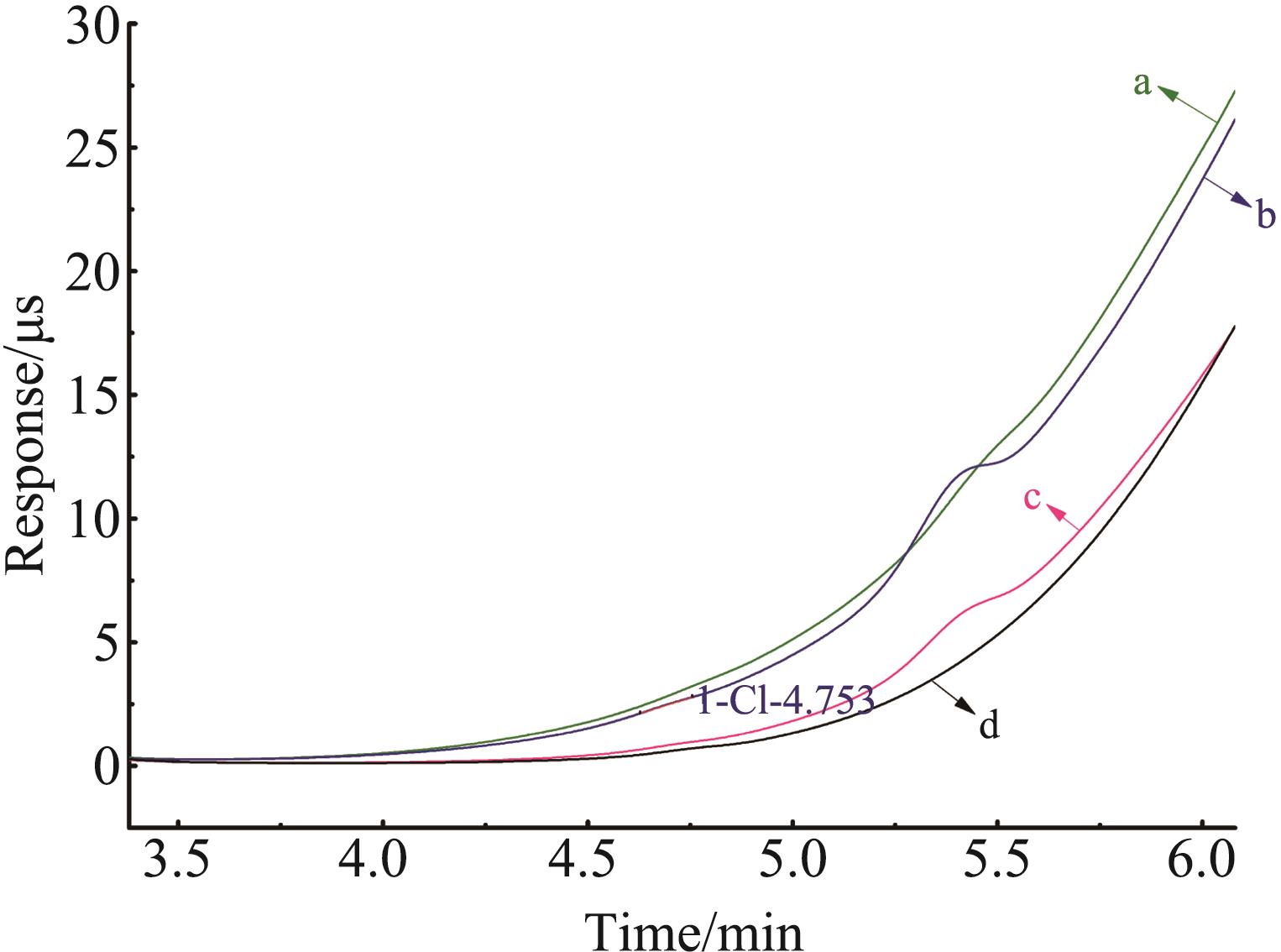
Fig.6 Cl- chromatogram of different titanium sponge samples tested by chromatographic columns in recent three years in the eluent concentration of 15 mmol/L
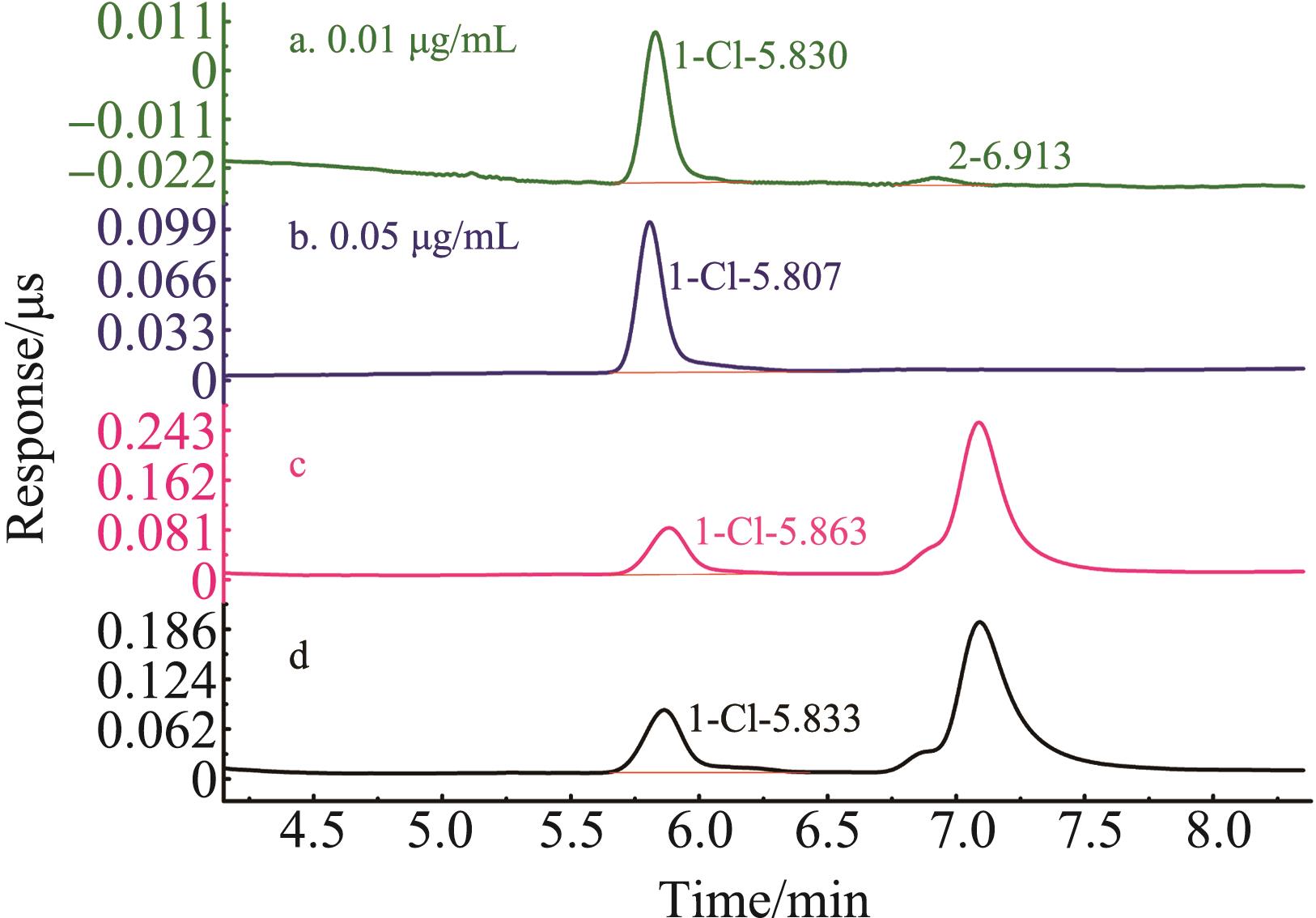
Fig.7 Chromatograms of the standard solution(a,b) and the titanium sponge sample(c,d)Gradient leaching procedure,Eluent concentration:15 mmol/L and 50 mmol/L
试样编号 Sample No. | 试样中氯质量分数 Found/% | 加入量 Added/ (μg·mL-1) | 测得值 Found/(μg·mL-1) | 平均值 Average | 回收率 Recovery/% | |
|---|---|---|---|---|---|---|
| 1 | 2 | |||||
| 7997 | 0.056 | 0.50 | 0.555 | 0.550 | 0.553 | 99 |
| 7887?1 | 0.050 | 0.50 | 0.579 | 0.577 | 0.578 | 106 |
| 7887?2 | 0.062 | 0.05 | 0.111 | 0.107 | 0.109 | 94 |
| 6613 | 0.039 | 0.03 | 0.069 | 0.066 | 0.068 | 97 |
| 7371 | 0.018 | 0.01 | 0.027 | 0.031 | 0.029 | 110 |
Table 3 Recoveries of samples collected
试样编号 Sample No. | 试样中氯质量分数 Found/% | 加入量 Added/ (μg·mL-1) | 测得值 Found/(μg·mL-1) | 平均值 Average | 回收率 Recovery/% | |
|---|---|---|---|---|---|---|
| 1 | 2 | |||||
| 7997 | 0.056 | 0.50 | 0.555 | 0.550 | 0.553 | 99 |
| 7887?1 | 0.050 | 0.50 | 0.579 | 0.577 | 0.578 | 106 |
| 7887?2 | 0.062 | 0.05 | 0.111 | 0.107 | 0.109 | 94 |
| 6613 | 0.039 | 0.03 | 0.069 | 0.066 | 0.068 | 97 |
| 7371 | 0.018 | 0.01 | 0.027 | 0.031 | 0.029 | 110 |
样品编号 Sample No. | 氯质量分数 Found/% | 允许差 Allowable deviation/% | 结果情况 Comparison result | ||
|---|---|---|---|---|---|
离子色谱法 Ion chromatography | 光度法 Photometry | 氯化银比浊法 Silver chloride turbidimetry | |||
| 4010 | 0.037 | 0.036 | <0.060 | 0.010 | Good agreement |
| 4518 | 0.057 | 0.055 | <0.060 | 0.022 | Good agreement |
| 5002?1 | 0.043 | 0.046 | <0.060 | 0.012 | Good agreement |
| 5082 | 0.029 | 0.028 | <0.060 | 0.009 | Good agreement |
| 5329?1 | 0.039 | 0.041 | <0.060 | 0.010 | Good agreement |
Table 4 Comparison of ion chromatography and photometry
样品编号 Sample No. | 氯质量分数 Found/% | 允许差 Allowable deviation/% | 结果情况 Comparison result | ||
|---|---|---|---|---|---|
离子色谱法 Ion chromatography | 光度法 Photometry | 氯化银比浊法 Silver chloride turbidimetry | |||
| 4010 | 0.037 | 0.036 | <0.060 | 0.010 | Good agreement |
| 4518 | 0.057 | 0.055 | <0.060 | 0.022 | Good agreement |
| 5002?1 | 0.043 | 0.046 | <0.060 | 0.012 | Good agreement |
| 5082 | 0.029 | 0.028 | <0.060 | 0.009 | Good agreement |
| 5329?1 | 0.039 | 0.041 | <0.060 | 0.010 | Good agreement |
| 1 | 王嵩, 刘禹明, 罗启顺, 等. 联合法生产海绵钛中杂质氯含量的控制[J]. 云南冶金, 2015, 44(4): 52-54, 63. |
| WANG S, LIU Y M, LUO Q S, et al. Study on content control of impurity chlorine in joint sponge titanium production[J]. Yunnan Metall, 2015, 44(4): 52-54, 63. | |
| 2 | 刘林, 龚厚亮, 仲利, 等. 超声波加速溶解-硝酸银比浊法测定海绵钛中氯[J]. 冶金分析, 2017, 37(3): 78-82. |
| LIU L, GONG H L, ZHONG L, et al. Determination of chlorine in sponge titanium by silver nitrate turbidmetry with ultrasonic accelerated dissolution[J]. Metall Anal, 2017, 37(3): 78-82. | |
| 3 | 惠秋红, 崔庆雄, 刘坤兰, 等. 极谱法快速测定海绵钛中的氯离子[J]. 云南冶金, 2013, 42(2): 101-103. |
| HUI Q H, CUI Q X, LIU K L, et al. Quick determination of chloride ion in titanium sponge by polarography method[J]. Yunnan Metall, 2013, 42(2): 101-103. | |
| 4 | 陶虹, 李玉清, 王举, 等. 一种自动电位滴定法测定海绵钛中氯含量的方法: 中国, 201310414547.1[P]. 2014-01-29. |
| TAO H, LI Y Q, WANG J, et al. A method for determination of chlorine content in titanium sponge by automatic potentiometric titration: CN, 201310414547.1[P]. 2014-01-29. | |
| 5 | 宋光林, 郭鹏然, 李晋庆, 等. 酸水解-离子色谱法测定精四氯化钛中三氯乙酰氯[J]. 分析化学, 2015, 43(6): 909-913. |
| SONG G L, GUO P R, LI J Q, et al. Determination of trichloroacetyl chloride in refine titanium tetrachloride by acid hydrolysis and ion chromatography[J]. Chinese J Anal Chem, 2015, 43(6): 909-913. | |
| 6 | MOHANA R S, KRAJMALNIKBROWN R, DELGADO A G, et al. An ion chromatography method for simultaneous quantification of chromate, arsenate, selenate, perchlorate, and other inorganic anions in environmental media[J]. Environ Eng Sci, 2021, 38(7): 626-634. |
| 7 | HU L, CHEN B. Determination of chlorine and bromine in plant materials by ion chromatography[J]. Agric Sci Technol, 2016, 17(10): 2403-2405. |
| 8 | DAI P, HOU D J, GUO S, et al. Ion chromatographic determination of total bromine in electronic devices in conjunction with a catalytic reduction debromination pretreatment[J]. Anal Chim Acta, 2019, 1082: 49-55. |
| 9 | CAI L, SU X J, XIONG X Y. Analysis of sugar components of fermented rice wine by ion chromatography[J]. Agric Sci Technol, 2013, 14(10): 1500-1502. |
| 10 | NOGUCHI Y, ZHANG L, MARUTA T, et al. Simultaneous determination of fluorine, chlorine and bromine in cement with ion chromatography after pyrolysis[J]. Anal Chim Acta, 2009, 640(1/2): 106-109. |
| 11 | YU X, SONG W, YU Q Q, et al. Fast screening compositions of PM2.5 by ATR-FTIR: comparison with results from IC and OC/EC analyzers[J]. J Environ Sci China, 2018, 71(9): 76-88. |
| 12 | 刘海霞, 狄婧, 饶红红, 等. 质子化壳聚糖功能性金纳米搅拌棒吸附萃取-离子色谱法测定乳制品中的亚硝酸盐及硝酸盐[J]. 分析化学, 2019, 47(9): 1395-1401. |
| LIU H X, DI J, RAO H H, et al. Determination of nitrite and nitrate in dairy products by protonated chitosan functionalized gold nanoarticles coated stir bar sorptive extraction with ion chromatography[J]. Chinese J Anal Chem, 2019, 47(9): 1395-1401. | |
| 13 | 陈磊, PHILIP H, 田芳, 等. 离子色谱法测定母乳中的寡聚糖与游离唾液酸[J]. 中国食品学报, 2019, 19(10): 227-234. |
| CHEN L, PHILIP H, TIAN F, et al. Determination of oligosaccharides and free sialic acid in human milk by ion chromatography[J]. Chinese Inst Food Sci Technol, 2019, 19(10): 227-234. | |
| 14 | 郑敬茹, 瞿厚淑, 付山, 等. 黄石市大气PM2.5中水溶性离子浓度特征及来源分析[J]. 环境科学研究, 2019, 32 (7): 1170-1178. |
| ZHENG J R, QU H S, FU S, et al. Characteristics and source analysis of water-soluble inorganic ions in PM2.5 in Huangshi city[J]. Res Environ Sci, 2019, 32(7): 1170-1178. | |
| 15 | 洪武兴, 田琼, 叶金燕, 等. 高温燃烧水解离子色谱法测定铬矿石中氟和氯[J]. 有色金属科学与工程, 2020, 11(4): 64-68. |
| HONG W X, TIAN Q, YE J Y, et al. Determination of fluorine and chlorine in chrome ore by high temperature combustion hydrolysis in ion chromatography[J]. Nonferrous Met Sci Eng, 2020, 11(4): 64-68. | |
| 16 | 王诗语, 凌凤香, 韩博, 等. 管式炉燃烧-离子色谱法测定固体生物质燃料中硫和氯[J]. 理化检验-化学分册, 2020, 56(7): 755-759. |
| WANG S Y, LING F X, HAN B, et al. IC determination of sulfur and chlorine in solid biomass fuel with tube furnace combustion [J]. Test Chem Anal Part B, 2020, 56(7): 755-759. | |
| 17 | 闫伊萌, 岳可心, 刘玉生, 等. 基于超高效液相色谱-四极杆-飞行时间串联质谱联用技术的黄英咳喘糖浆化学成分分析[J]. 应用化学, 2021, 38(3): 276-288. |
| YAN Y M, YUE K X, LIU Y S, et al. Characterization of components in huangying kechuan syrup by ultra-high liquid chromatography tandem quadrupole-time-of-flight mass spectrometry[J]. Chinese J Appl Chem, 2021, 38(3): 276-288. |
| [1] | Gao-Yong ZI, Bang-Fu HUANG, Meng DAI, Zheng-Yu YANG, Zhen-Jing WEN, Wan-Jun LI, Liu-Bin LUO. Effect of Chlorine Removal on Crystallization in the Mother Liquor of Ammonium Sulfate [J]. Chinese Journal of Applied Chemistry, 2022, 39(9): 1437-1446. |
| [2] | MA Qing-Hua, ZHU Xiang-Guo, ZHENG Jia, LIU Gang, DU Lin. Relative Molecular Mass Distribution of Tetanus Toxoid Determined by Gel Exclusion Chromatography and Multi Angle Laser Scattering [J]. Chinese Journal of Applied Chemistry, 2021, 38(6): 739-742. |
| [3] | WANG Cong, ZHAO Xiao-Yu, WANG Hai-Yan, CAO Jin, WANG Gang-Li. Detection of 73 Veterinary Drugs Residues in Animal Muscle Tissues by High Performance Liquid Chromatography-Triple Quadrupole Mass Spectrometry [J]. Chinese Journal of Applied Chemistry, 2021, 38(12): 1663-1675. |
| [4] | YAN Pengfei,WU Liang,YAO Jingfen,LIU Haidong,GUO Anru. Determination of Total Fluoride in Chemical Milling Etching Solution for Titanium Alloys by in-situ Hydrolysis-Lanthanum Nitrate Potentiometric Titration Method [J]. Chinese Journal of Applied Chemistry, 2018, 35(6): 729-734. |
| [5] | MA Miao,HUANG Yudai,GUO Yong,JIA Dianzeng,TANG Xincun,WANG Xingchao,PAN Yanliang. Determination of Speciation in White Ash and Acid Leaching Arsenic Removal Technique [J]. Chinese Journal of Applied Chemistry, 2015, 32(10): 1208-1214. |
| [6] | ZHANG Sheli1*, XU Wenjing1, FAN Yunchang2. Determination of Methenamine in Dried Beancurd Stick and Bean Vermicelli by Ion Chromatography [J]. Chinese Journal of Applied Chemistry, 2014, 31(11): 1352-1355. |
| [7] | FAN Yanqun1,2, XU Jianzhong2, XU Xun1,2, LIU Yijie3, XU Chen2*. Simultaneous Determination of Glucuronic Acid and Glucuronolactone Using Ion-exclusion Chromatography [J]. Chinese Journal of Applied Chemistry, 2014, 31(04): 450-454. |
| [8] | GAO Jinlong, WU Haixia, ZHANG Congjing, WANG Kuitao*. Corrosion Inhibition Performance of Fluorocarbon Surfactant FY-F501 for Aluminum Alloy [J]. Chinese Journal of Applied Chemistry, 2014, 31(03): 348-353. |
| [9] | LUO Qimei, WANG Huixian, LIU Dengyou*, WANG Ling. Determination of Catechol with Graphene Modified Glassy Carbon Electrode [J]. Chinese Journal of Applied Chemistry, 2012, 29(09): 1070-1074. |
| [10] | CHEN Huan, MA Wei, SUN Dengming*. Simultaneous Determination of Hydroquinone and Catechol at the Silver Doped Poly(L-methionine) Modified Glassy Carbon Electrode [J]. Chinese Journal of Applied Chemistry, 2012, 29(05): 576-584. |
| [11] | LI Jingyun, WANG Yi, XU Jiali, LI Yuanfang*. Detection of Cefazolin Based on the Plasma Resonance Absorption of Gold Nanoparticles [J]. Chinese Journal of Applied Chemistry, 2012, 29(04): 455-461. |
| [12] | ZENG Zhi1,2*, XIE Runqian1, TAN Lixian1, ZHANG Tao3. GC-MS Analysis and Determination of Chemical Components of the Extracts from Ligusticum Chuanxiong Hort. by Steam Distillation and Supercritical CO2 Extraction [J]. Chinese Journal of Applied Chemistry, 2011, 28(08): 956-962. |
| [13] | SU Zhonghua, WANG Yajing, ZHAO Huan, HU Yamei, TANG Chunran, LI Xiafei, LI Jin, ZENG Yunlong*. Determination of Trace Copper(Ⅱ) Using CdS Quantum Dots as a Fluorescence Probe [J]. Chinese Journal of Applied Chemistry, 2011, 28(07): 842-848. |
| [14] | REN Yanyan, JIN Gendi, HU Xiaoya*. Electrochemical Determination of Erythromycin Ethylsuccinate Using a Carbon Paste Electrode [J]. Chinese Journal of Applied Chemistry, 2011, 28(06): 704-708. |
| [15] | GUO Yanyan, YIN Weiping*, LIU Pu, HU Ya, YAN Mengjie, SUN Xiangqian. Extraction and Separation of Isoflavonoids from Rhynchosia volubilis Lour Using Ionic Liquid [J]. Chinese Journal of Applied Chemistry, 2011, 28(05): 537-541. |
| Viewed | ||||||
|
Full text |
|
|||||
|
Abstract |
|
|||||
